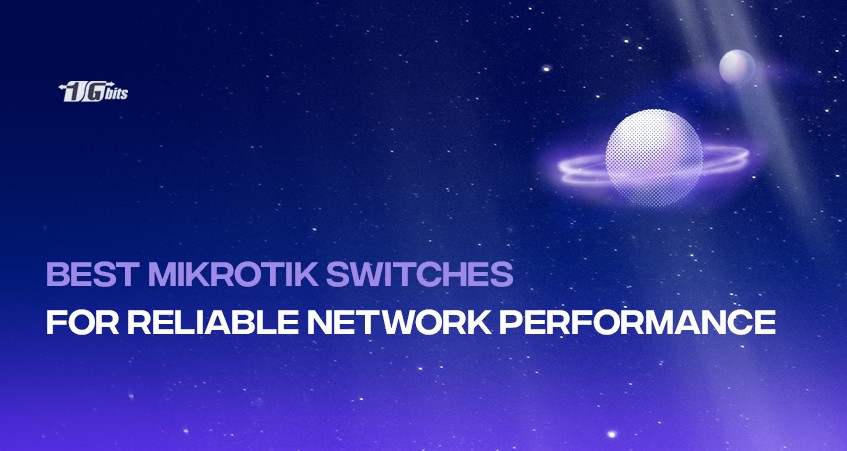Mikrotik switches are popular among IT professionals and network administrators due to their high-quality performance, advanced features, and affordable prices; they offer a range of switches designed for various network sizes and purposes, from small businesses to large enterprises. However, with so many Mikrotik switches available in the market, it can be tricky to determine which is best for your network. In this article, we will outline the top Mikrotik switches available in the market, compare their features and functionalities, explore the factors to consider when selecting the right switch and provide recommendations based on the network size and requirements. Whether upgrading your existing network or starting a new one, this article will help you find the best Mikrotik switch.
When setting up your Mikrotik switches, integrating secure connections is essential for protecting your network. To ensure a secure and efficient configuration, don't miss our detailed guide on OpenVPN configuration on Mikrotik. This resource will walk you through the steps necessary to establish a VPN connection, enhancing your network security and performance.
What Are Mikrotik Switches?
Mikrotik switches are network devices designed to connect multiple devices within a network. They are created by Mikrotik, a Latvian company specialising in developing networking equipment, and they are widely used for their high-performance features and affordability. Mikrotik switches offer a range of advanced features, such as VLAN, QoS, and link aggregation, which allow network administrators to optimize network performance and improve security. Mikrotik switches come in different sizes and port counts, ranging from 5 to 48 ports, making them suitable for small businesses, medium-sized enterprises, and even large corporations.
One of the significant advantages of Mikrotik switches is their management capabilities. They are highly configurable and can be managed through a web interface, command-line interface, or API. The user-friendly web interface allows network administrators to configure settings, monitor traffic, and troubleshoot issues. The command-line interface is ideal for advanced users who prefer configuring switches using text commands and scripts. The API interface suits developers who want to automate network management tasks. Overall, Mikrotik switches offer high control and flexibility, making them a popular choice for businesses and organizations of all sizes.
To maximize the functionality of your Mikrotik switches, it's essential to know how to connect to your Mikrotik router effectively. If you're using an Android device for this purpose, be sure to read our guide on how to connect to a Mikrotik router from Android for detailed instructions and tips. This knowledge will help you manage your network seamlessly, leveraging the full potential of your Mikrotik hardware.
The Best Mikrotik Switches
Mikrotik CRS328-24P-4S+RM
The Mikrotik CRS328-24P-4S RM is a rack-mountable network switch with a capacity of 24 Gigabit Ethernet ports and 4 SFP+ ports. This switch has a powerful CPU that can handle complex networks and provides a great user experience. The CRS328 series is designed for small to medium businesses and provides reliable performance at a lower cost than other enterprise-grade switches. The device includes Layer 2 features such as VLAN, STP, RSTP, MSTP, IGMP, MLD, ACL and MAC filtering, and MAC transparency. The CRS328-24P-4S RM can support up to 30W power output per port, making it an excellent choice for powering devices such as IP cameras, wireless access points, and VoIP phones.
One of the main features of the Mikrotik CRS328-24P-4S RM is the PoE functionality. The switch can provide power to PoE devices without requiring an external power source, reducing the need for extra cables and power outlets. The device also has a built-in 1U rack-mountable enclosure, making it easy to install in a server room or data center. The switch has a powerful CPU that can handle complex networks, providing a great user experience. The CRS328-24P-4S RM also has a web interface that is easy to navigate, allowing users to manage the switch and configure features from anywhere in the network.
The Mikrotik CRS328-24P-4S RM has several pros and cons. One of the pros is its compact design. Despite having 24 Gigabit Ethernet and 4 SFP+ ports, the switch is small enough to fit in a 1U rack-mountable enclosure. The switch also has PoE functionality, providing power to other devices without requiring an external power source. The device's web interface is easy to navigate, allowing users to manage the switch and configure features anywhere in the network. A potential downside to the device is that it does not have Layer 3 functionality, which may limit its use in more complex networks. Additionally, the switch's 30W power output per port may not be enough for high-powered devices, such as some APs, requiring an additional power source.
When considering the Mikrotik CRS328-24P-4S RM, it’s important to also evaluate how it stacks up against competitors in the networking market. For a comprehensive comparison, take a look at our analysis of Cisco vs. Mikrotik, which highlights the strengths and weaknesses of both brands, helping you make a more informed decision for your network setup.
Mikrotik CRS317-1G-16S+RM
The Mikrotik CRS317-1G-16S RM is a powerful and versatile switch for advanced network configurations. With 16 SFP+ ports and a single Gigabit Ethernet port, this switch connects servers, routers, and other network devices in a data center or large office setting. The switch is rack-mountable and features a compact design that helps to optimize space while still providing maximum functionality.
One of the key features of the Mikrotik CRS317-1G-16S RM is its ability to support multiple VLAN configurations, which makes it an ideal choice for organizations that require separate network segments for different users or applications. The switch also includes advanced Layer 2 features such as IGMP snooping, port mirroring, and link aggregation, which help to optimize network performance and improve overall efficiency. Additionally, the device supports a range of advanced routing protocols, including OSPF, BGP, and RIP, which makes it an excellent choice for complex network environments.
Overall, the Mikrotik CRS317-1G-16S RM is a powerful and versatile switch that offers a wide range of advanced features and capabilities. The device is well-suited for organizations that require a high-performance network infrastructure, and its compact design and easy-to-use management interface make it a great option for IT managers who need to configure and monitor complex network environments. While the device does have a relatively high price point compared to some other switches on the market, its advanced features and capabilities make it well worth the investment for organizations that require a robust and reliable networking infrastructure.
One of the primary pros of the Mikrotik CRS317-1G-16S RM is its advanced feature set, which includes support for multiple VLAN configurations, advanced routing protocols, and a range of Layer 2 functionality. The switch is also designed for ease of use, with a user-friendly management interface that allows IT managers to configure and monitor network devices easily. Additionally, the compact design and rack-mountable form factor make the device an ideal choice for organizations requiring maximum functionality in a limited space.
One of the cons of the Mikrotik CRS317-1G-16S RM is its relatively high price point, which may be a barrier for some organizations on a tight budget. The device also requires certain technical expertise to configure and deploy, which may be a challenge for organizations that lack a dedicated IT team. Finally, the switch does not include any Power over Ethernet (PoE) functionality, which may be a drawback for organizations requiring PoE capabilities to power network devices such as IP phones or security cameras.
Mikrotik CRS328-4C-20S-4S+RM
The Mikrotik CRS328-4C-20S-4S RM is a high-performance switch designed to meet the needs of modern data centers and large-scale network environments. The switch features 4 Gigabit Ethernet ports and 20 SFP+ ports, and an additional 4 SFP+ ports for uplink connectivity. The device is also rack-mountable and features a compact form factor that helps to optimize space while still providing maximum functionality.
A key feature of the Mikrotik CRS328-4C-20S-4S RM is its advanced Layer 3 functionality, which includes support for OSPF, BGP, and RIP routing protocols. This makes the device an ideal choice for organizations that require sophisticated routing capabilities to optimize network performance and ensure reliable connectivity. Additionally, the switch includes advanced security features such as MAC filtering, VLAN filtering, and advanced access control mechanisms, which help ensure network data's integrity and confidentiality.
The Mikrotik CRS328-4C-20S-4S RM is a powerful and versatile switch well-suited for many network environments. The device's advanced feature set and compact design make it an ideal choice for organizations that require high-performance networking infrastructure in a limited space. While the device has a relatively high price point compared to some other switches on the market, it's advanced capabilities and robust functionality makes it well worth the investment for organizations that require a reliable and secure network infrastructure.
One of the primary pros of the Mikrotik CRS328-4C-20S-4S RM is its advanced Layer 3 functionality, which includes support for a range of routing protocols and advanced security features. The switch is also designed for ease of use, with a user-friendly management interface that allows IT managers to configure and monitor network devices easily. Additionally, the device's compact form factor and high-performance capabilities make it an ideal choice for organizations that require reliable and secure networking infrastructure in a limited space.
As for the cons of the Mikrotik, CRS328-4C-20S-4S RM is its relatively high price point, which may be a barrier for some organizations on a tight budget. The device also requires certain technical expertise to configure and deploy, which may be a challenge for organizations that lack a dedicated IT team. Finally, the switch does not include any Power over Ethernet (PoE) functionality, which may be a drawback for organizations requiring PoE capabilities to power network devices such as IP phones or security cameras. However, the device provides a powerful and reliable networking solution for organizations that need advanced capabilities and robust functionality.
Factors to Consider When Choosing a Mikrotik Switch
Mikrotik switches are known for their reliability, affordability, and flexibility. When choosing a Mikrotik switch, several factors must be considered to ensure that you get the right switch for your needs.
- Port Count: One of the most important factors to consider is the port count. The port count will determine how many devices you can connect to your switch. If you have a lot of devices that need to connect to your network, you will need a switch with a high port count. Conversely, you can opt for a switch with fewer ports if you have a small network.
- Switching Capacity: Another important factor to consider is the switching capacity of the switch. Switching capacity refers to the amount of data that can be transferred through the switch at any time. If you have high data traffic on your network, you will need a switch with a high switching capacity. This will ensure that your network runs smoothly without any lag or delays.
- Power over Ethernet (PoE): PoE is also important when choosing a Mikrotik switch. PoE allows you to power devices such as IP cameras, wireless access points, and VoIP phones directly from the switch without needing a separate power source. If you have a lot of PoE devices on your network, you must choose a switch that supports PoE.
- Cost: Finally, the cost is a crucial factor to consider when choosing a Mikrotik switch. You should choose a switch that fits your budget, but you should also ensure that you get the features and capabilities you need. Investing in a high-quality switch that will last for years and provide reliable performance is always better than opting for a cheaper switch that may not meet your needs.
When choosing a Mikrotik switch, it is important to consider factors such as port count, switching capacity, PoE, and cost. Considering these factors, you can choose a switch that will meet your current and future networking needs, provide reliable performance, and fit your budget.
When selecting the right Mikrotik switch, it's also beneficial to understand how it compares to other networking solutions. For a comprehensive analysis of network management options, consider exploring the differences between Mikrotik and pfSense in our detailed comparison of Mikrotik vs. pfSense. This will help you make a more informed decision based on your networking requirements.
Summing Up
Mikrotik switches are an excellent choice for building a reliable and efficient network. With their advanced features, flexible configurations, and affordability, these switches offer great value for businesses of all sizes. There are many options, whether you need a switch for a small network or a large enterprise. The best Mikrotik switches offer a combination of high port count, high switching capacity, PoE support, and affordable pricing. You can find the perfect Mikrotik switch to help your business thrive by considering your specific networking needs and budget.
When evaluating the best Mikrotik switches for your network, it’s also worth considering how they compare to other brands. For a detailed comparison of Mikrotik and Ubiquiti, check out our article on Mikrotik vs. Ubiquiti, which highlights the strengths and weaknesses of each brand to help you make an informed decision for your networking needs.
Additionally, if you're looking to integrate your Mikrotik switches into a virtualized environment, considering a Mikrotik VPS server can further enhance your network's flexibility and scalability. With their exceptional quality and performance, Mikrotik switches, combined with a well-configured VPS server, will provide a reliable foundation for your network for many years.
- Mikrotik switches are network devices that connect devices in a local area network, offering features such as VLAN, QoS, and link aggregation to ensure reliable network performance.
- When choosing a Mikrotik switch, consider the number of ports, PoE support, link aggregation capability, and switch type (managed or unmanaged).
- Mikrotik's CRS328-24P-4S-IN switch offers 24 ports, 4 SFP ports, and PoE support, making it perfect for small businesses and home networks.
- Mikrotik's CRS317-1G-16S+RM switch has 16 SFP+ ports and 1 Gigabit Ethernet port, making it ideal for data centers and high-performance computing applications.










